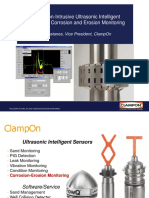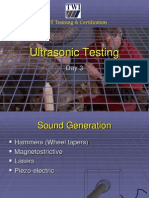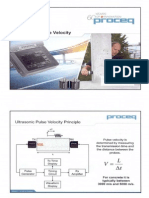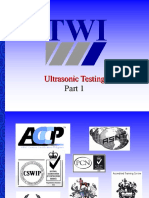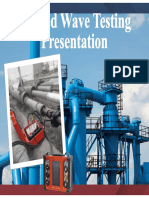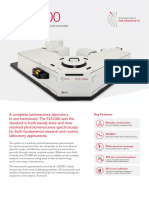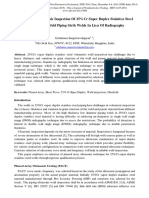Pundit Transducer Selection Guide Adj
Uploaded by
jatineorCopyright:
Available Formats
Pundit Transducer Selection Guide Adj
Uploaded by
jatineorCopyright
Available Formats
Share this document
Did you find this document useful?
Is this content inappropriate?
Copyright:
Available Formats
Pundit Transducer Selection Guide Adj
Uploaded by
jatineorCopyright:
Available Formats
PUNDIT
Ultrasonic Transducer Selection Guide
Physical Influences on Transducer Selection
Selecting the correct transducer for an application is largely dependent on the
aggregate (grain) size and the dimensions of the test object.
Effect of Particle Size
Inhomogeneities (e.g. aggregate particles, voids) in concrete influence the propagation
of an ultrasound pulse by scattering the signal. The effect is significant if the size of the
aggregate is equal to or larger than the wavelength of the ultrasonic signal. This
influence can be significantly reduced by choosing the pulse frequency, such that the
wavelength is at least twice as large as the aggregate size. Also be aware that it is very
difficult to detect an anomaly if it is smaller than half the wavelength. There is a balance
between effective wave penetration and anomaly location.
For rocks and other fine grained materials such as ceramics and wood, the grain size is
less significant. For such materials, the size of the object to be tested is the most
significant factor.
Best results have been obtained on wood with 54 kHz.
For ceramics, the small sample size and fine grain means that 250 kHz or 500
kHz is most widely used.
Effect of Sample Size
The pulse velocity is reduced significantly if the lateral
dimensions (perpendicular to the direction of
transmission) is less than the wavelength. Keep the object
D
lateral dimensions about twice the depth to reduce noise.
The depth must also be larger than the wavelength to
ensure complete wave formation. L ≈ 2D
Higher frequency signals have a better-defined edge and therefore make it easier to
identify the onset of the received pulse. However, they are more influenced by
scattering. A 500 kHz signal has a wavelength of around 7 mm (assuming the speed of
sound to be 3500 m/s) and is heavily scattered by the coarse aggregate in concrete,
limiting the transmission to a few decimeters at most.
For more information, find us at: www.screeningeagle.com +1 (724) 512-0330
04/2024
On the opposite end of the scale, a 24 kHz signal has a wavelength of around 150 mm
and is largely unaffected by scattering. The maximum transmission range may be
several meters.
Transducer Selection Guideline
The wavelength may be easily calculated:
𝑈𝑙𝑡𝑟𝑎𝑠𝑜𝑛𝑖𝑐 𝑃𝑢𝑙𝑠𝑒 𝑉𝑒𝑙𝑜𝑐𝑖𝑡𝑦
𝑊𝑎𝑣𝑒𝑙𝑒𝑛𝑔𝑡ℎ =
𝐹𝑟𝑒𝑞𝑢𝑒𝑛𝑐𝑦
For concrete, the ultrasonic pulse velocity (UPV) ranges from 3000 m/s (poor quality) to
5000 m/s (high quality). An average value for ordinary concrete of 3700 m/s has been
used in the following table for the maximum grain size and the minimum lateral
dimension of the test object.
Frequency
54 kHz 40 kHz
24 kHz 54 kHz 150 kHz 250 kHz 500 kHz
Exponential Shear wave
Transducer Dimensions
Max grain size
≈ 77 mm ≈ 34 mm ≈ 34 mm ≈ 12 mm ≈ 7 mm ≈ 3 mm ≈ 46 mm
≈ 3 in ≈ 1.3 in ≈ 1.3 in ≈ 0.5 in ≈ 0.25 in ≈ 0.1 in ≈ 1.8 in
Min lateral
154 mm 69 mm 69 mm 25 mm 15 mm 7 mm 92 mm
6 in 2.7 in 2.7 in 1 in 0.6 in 0.3 in 3.6 in
Small Refractory
Mass Rough Ceramics, Elastic
Application
samples, bricks,
concrete, Most surfaces, very fine modulus,
cement, fine
coarse applications concrete, grained Poisson’s
rock, grained
aggregates rock, wood rocks ratio
wood rocks
For more information, find us at: www.screeningeagle.com +1 (724) 512-0330
04/2024
For ultrasonic measurements made on rock, ASTM D2845 recommends a minimum
lateral dimension of 5x the wavelength. It also recommends using a wavelength at least
3x the average grain size.
e.g. An NX core specimen has a diameter of 54.7 mm. A transducer frequency of 250
kHz or 500kHz would be recommended for this size of specimen based on this
recommendation, (depending on pulse velocity of the rock types to be tested).
Maximum grain size would be 5 mm or 2.33 mm respectively.
Specialized Transducers
Exponential Transducers
When UPV measurements are made with flat face probes on materials having very
rough or curved surfaces, there is a marked reduction in received signal amplitude due
to increased attenuation at the transducer – material interface.
The Exponential Probe has been designed to enable measurements to be made on
materials with these surface limitations without resort to surface grinding or use of
thick couplant. The signal strength is not as strong as the standard transducer and
therefore it is recommended to use only when necessary.
Shear Wave Transducers
For use in conjunction with P-wave measurements to determine Poisson’s ratio and the
dynamic modulus of elasticity. This transducer uses spring loaded dry point contact
transducer elements removing the need for couplant gel.
During data collection, ensure the BNC connectors are aligned for a strong shear wave
component. When determining the shear wave arrival, pick the location of the first
significant negative peak. As the shear wave travels through the material, there is some
wave conversion creating a weak longitudinal wave that will arrive first.
Transducer Holder
For concrete quality assessment to
keep consistent transducer spacing
and for one handed transducer
positioning.
For more information, find us at: www.screeningeagle.com +1 (724) 512-0330
04/2024
Ordering Information
Transducers
325 40 026 Transducer 24 kHz
325 40 131 Transducer 54 kHz
325 40 141 Transducer 150 kHz
325 40 176 Exponential Transducer 54 kHz
325 40 177 Transducer 250 kHz
325 40 175 Transducer 500 kHz
325 40 210 Shear wave transducer 40 kHz
Accessories
325 40 150 Transducer holder
327 01 049 PL-200 BNC adapter cable
325 40 021 Cable with BNC plug, L= 1.5 m (5 ft)
325 40 022 Cable with BNC plug, L = 10 m (33 ft)
710 10 031 Ultrasound couplant, 250 ml bottle
The PL-200 platform is able to support custom p-wave transducers with frequencies
between 20 and 500 kHz.
For more information, find us at: www.screeningeagle.com +1 (724) 512-0330
04/2024
You might also like
- Southern Instrumentation Armoured XLPE - OSCR - PVC - SWA - PVC - FR - 1No ratings yetSouthern Instrumentation Armoured XLPE - OSCR - PVC - SWA - PVC - FR - 13 pages
- Signature VM Coastal - 1000 - 500 - 250 KHZNo ratings yetSignature VM Coastal - 1000 - 500 - 250 KHZ8 pages
- Banner Engineering - Glass Fiber Series - CatalogNo ratings yetBanner Engineering - Glass Fiber Series - Catalog43 pages
- A V-Band Waveguide To Microstrip Probe TransitionNo ratings yetA V-Band Waveguide To Microstrip Probe Transition3 pages
- Riverq Adcp: Discrete Discharge Measurements 300Khz / 600Khz / 1200KhzNo ratings yetRiverq Adcp: Discrete Discharge Measurements 300Khz / 600Khz / 1200Khz2 pages
- V New Cygnus 4 Plus General Purpose BrochureNo ratings yetV New Cygnus 4 Plus General Purpose Brochure4 pages
- Ts-Po16392-2cx10mm, 3CX6MM, 3CX10MM, 4CX6MM, 4CX16MMNo ratings yetTs-Po16392-2cx10mm, 3CX6MM, 3CX10MM, 4CX6MM, 4CX16MM2 pages
- Ultrasonic Testing: NDT Training & CertificationNo ratings yetUltrasonic Testing: NDT Training & Certification48 pages
- Flexar UVVis LC and UHPLC Detectors Specification S SheetNo ratings yetFlexar UVVis LC and UHPLC Detectors Specification S Sheet1 page
- Ultrasonic Testing (UT) : The Engineers Edge Institute of NDTNo ratings yetUltrasonic Testing (UT) : The Engineers Edge Institute of NDT83 pages
- Instrumentation of Uv Spectrophotometer: - Pranav Kumar Singh M.Sc.-Applied Chemistry (Third Semester)No ratings yetInstrumentation of Uv Spectrophotometer: - Pranav Kumar Singh M.Sc.-Applied Chemistry (Third Semester)32 pages
- Non-Destructive Testing: Fabrication, Welding and Inspection Basics For Maintenance EngineerNo ratings yetNon-Destructive Testing: Fabrication, Welding and Inspection Basics For Maintenance Engineer6 pages
- Assessment of The Capabilities of Long-Range Guided-Wave Ultrasonic InspectionsNo ratings yetAssessment of The Capabilities of Long-Range Guided-Wave Ultrasonic Inspections23 pages
- IPTC-10546-MS - A Novel Ultrasonic Cased-Hole Imager For Enhanced Cement Evaluation by Vankuijk 2005No ratings yetIPTC-10546-MS - A Novel Ultrasonic Cased-Hole Imager For Enhanced Cement Evaluation by Vankuijk 200514 pages
- Multi-Purpose, Multi-Tissue Ultrasound Phantom: The Standard For Ultrasound Quality AssuranceNo ratings yetMulti-Purpose, Multi-Tissue Ultrasound Phantom: The Standard For Ultrasound Quality Assurance2 pages
- Ultrasonic Clamp On Insertion Flow MeterNo ratings yetUltrasonic Clamp On Insertion Flow Meter4 pages
- MaxQ 3000 Benchtop Open-Air Platform Shakers ManualNo ratings yetMaxQ 3000 Benchtop Open-Air Platform Shakers Manual30 pages
- Anusavice K.J., Shen C., Rawls H.R. - Phillips' Science of Dental Materials-490-513No ratings yetAnusavice K.J., Shen C., Rawls H.R. - Phillips' Science of Dental Materials-490-51324 pages
- A Tutorial On Creating A Custom SPICE Component For Multisim - Apr 8th 2011No ratings yetA Tutorial On Creating A Custom SPICE Component For Multisim - Apr 8th 20115 pages
- 487E Test Current Calculator - 13JAN2010No ratings yet487E Test Current Calculator - 13JAN20103 pages
- KV-5500/5000/3000 KV-DR1: Programmable ControllerNo ratings yetKV-5500/5000/3000 KV-DR1: Programmable Controller2 pages
- 2014 05 08 Brochure HVDC Theory and Controls and Project Management V7No ratings yet2014 05 08 Brochure HVDC Theory and Controls and Project Management V72 pages
- 2.CALENBERG Vibration Insulation Bearings Civalit Sliding Bearing enNo ratings yet2.CALENBERG Vibration Insulation Bearings Civalit Sliding Bearing en4 pages
- Southern Instrumentation Armoured XLPE - OSCR - PVC - SWA - PVC - FR - 1Southern Instrumentation Armoured XLPE - OSCR - PVC - SWA - PVC - FR - 1
- Riverq Adcp: Discrete Discharge Measurements 300Khz / 600Khz / 1200KhzRiverq Adcp: Discrete Discharge Measurements 300Khz / 600Khz / 1200Khz
- Ts-Po16392-2cx10mm, 3CX6MM, 3CX10MM, 4CX6MM, 4CX16MMTs-Po16392-2cx10mm, 3CX6MM, 3CX10MM, 4CX6MM, 4CX16MM
- Flexar UVVis LC and UHPLC Detectors Specification S SheetFlexar UVVis LC and UHPLC Detectors Specification S Sheet
- Ultrasonic Testing (UT) : The Engineers Edge Institute of NDTUltrasonic Testing (UT) : The Engineers Edge Institute of NDT
- Instrumentation of Uv Spectrophotometer: - Pranav Kumar Singh M.Sc.-Applied Chemistry (Third Semester)Instrumentation of Uv Spectrophotometer: - Pranav Kumar Singh M.Sc.-Applied Chemistry (Third Semester)
- Non-Destructive Testing: Fabrication, Welding and Inspection Basics For Maintenance EngineerNon-Destructive Testing: Fabrication, Welding and Inspection Basics For Maintenance Engineer
- Assessment of The Capabilities of Long-Range Guided-Wave Ultrasonic InspectionsAssessment of The Capabilities of Long-Range Guided-Wave Ultrasonic Inspections
- IPTC-10546-MS - A Novel Ultrasonic Cased-Hole Imager For Enhanced Cement Evaluation by Vankuijk 2005IPTC-10546-MS - A Novel Ultrasonic Cased-Hole Imager For Enhanced Cement Evaluation by Vankuijk 2005
- Multi-Purpose, Multi-Tissue Ultrasound Phantom: The Standard For Ultrasound Quality AssuranceMulti-Purpose, Multi-Tissue Ultrasound Phantom: The Standard For Ultrasound Quality Assurance
- Learn Amateur Radio Electronics on Your SmartphoneFrom EverandLearn Amateur Radio Electronics on Your Smartphone
- MaxQ 3000 Benchtop Open-Air Platform Shakers ManualMaxQ 3000 Benchtop Open-Air Platform Shakers Manual
- Anusavice K.J., Shen C., Rawls H.R. - Phillips' Science of Dental Materials-490-513Anusavice K.J., Shen C., Rawls H.R. - Phillips' Science of Dental Materials-490-513
- A Tutorial On Creating A Custom SPICE Component For Multisim - Apr 8th 2011A Tutorial On Creating A Custom SPICE Component For Multisim - Apr 8th 2011
- 2014 05 08 Brochure HVDC Theory and Controls and Project Management V72014 05 08 Brochure HVDC Theory and Controls and Project Management V7
- 2.CALENBERG Vibration Insulation Bearings Civalit Sliding Bearing en2.CALENBERG Vibration Insulation Bearings Civalit Sliding Bearing en





